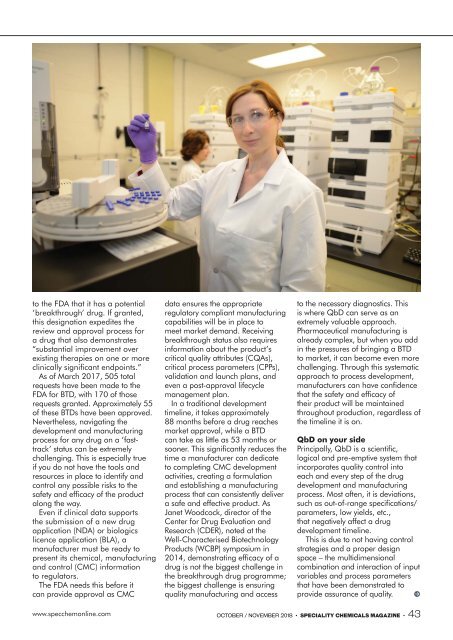Speciality Chemicals Magazine October_November 2018
Speciality Chemicals Magazine is the number one and longest published global magazine dedicated exclusively to the fine and speciality chemicals industries. Our unrivalled reputation for comprehensive coverage and perspective on the global chemical industry makes the magazine essential reading for everyone involved in this market. Speciality Chemicals Magazine has the best established global industry specific print and digital circulation with over 52,000 targeted individuals and distribution to shows and events worldwide. These are personalised subscribers who have requested to be sent a copy of the magazine. This circulation has been built up over 37 years of publishing and has been cleared to European Data Protection Standards (EDPS) 2018. In addition to this personalised circulation, selected articles and industry news are posted on our website, social media sites and in your bi-weekly newsletter.
Speciality Chemicals Magazine is the number one and longest published global magazine dedicated exclusively to the
fine and speciality chemicals industries. Our unrivalled reputation for comprehensive coverage and perspective on the global
chemical industry makes the magazine essential reading for everyone involved in this market.
Speciality Chemicals Magazine has the best established global industry specific print and digital circulation with over
52,000 targeted individuals and distribution to shows and events worldwide. These are personalised subscribers who have requested to be sent a copy of the magazine.
This circulation has been built up over 37 years of publishing and has been cleared to European Data Protection Standards (EDPS) 2018.
In addition to this personalised circulation, selected articles and industry news are posted on our website,
social media sites and in your bi-weekly newsletter.
Create successful ePaper yourself
Turn your PDF publications into a flip-book with our unique Google optimized e-Paper software.
to the FDA that it has a potential<br />
‘breakthrough’ drug. If granted,<br />
this designation expedites the<br />
review and approval process for<br />
a drug that also demonstrates<br />
“substantial improvement over<br />
existing therapies on one or more<br />
clinically significant endpoints.”<br />
As of March 2017, 505 total<br />
requests have been made to the<br />
FDA for BTD, with 170 of those<br />
requests granted. Approximately 55<br />
of these BTDs have been approved.<br />
Nevertheless, navigating the<br />
development and manufacturing<br />
process for any drug on a ‘fasttrack’<br />
status can be extremely<br />
challenging. This is especially true<br />
if you do not have the tools and<br />
resources in place to identify and<br />
control any possible risks to the<br />
safety and efficacy of the product<br />
along the way.<br />
Even if clinical data supports<br />
the submission of a new drug<br />
application (NDA) or biologics<br />
licence application (BLA), a<br />
manufacturer must be ready to<br />
present its chemical, manufacturing<br />
and control (CMC) information<br />
to regulators.<br />
The FDA needs this before it<br />
can provide approval as CMC<br />
data ensures the appropriate<br />
regulatory compliant manufacturing<br />
capabilities will be in place to<br />
meet market demand. Receiving<br />
breakthrough status also requires<br />
information about the product’s<br />
critical quality attributes (CQAs),<br />
critical process parameters (CPPs),<br />
validation and launch plans, and<br />
even a post-approval lifecycle<br />
management plan.<br />
In a traditional development<br />
timeline, it takes approximately<br />
88 months before a drug reaches<br />
market approval, while a BTD<br />
can take as little as 53 months or<br />
sooner. This significantly reduces the<br />
time a manufacturer can dedicate<br />
to completing CMC development<br />
activities, creating a formulation<br />
and establishing a manufacturing<br />
process that can consistently deliver<br />
a safe and effective product. As<br />
Janet Woodcock, director of the<br />
Center for Drug Evaluation and<br />
Research (CDER), noted at the<br />
Well-Characterised Biotechnology<br />
Products (WCBP) symposium in<br />
2014, demonstrating efficacy of a<br />
drug is not the biggest challenge in<br />
the breakthrough drug programme;<br />
the biggest challenge is ensuring<br />
quality manufacturing and access<br />
to the necessary diagnostics. This<br />
is where QbD can serve as an<br />
extremely valuable approach.<br />
Pharmaceutical manufacturing is<br />
already complex, but when you add<br />
in the pressures of bringing a BTD<br />
to market, it can become even more<br />
challenging. Through this systematic<br />
approach to process development,<br />
manufacturers can have confidence<br />
that the safety and efficacy of<br />
their product will be maintained<br />
throughout production, regardless of<br />
the timeline it is on.<br />
QbD on your side<br />
Principally, QbD is a scientific,<br />
logical and pre-emptive system that<br />
incorporates quality control into<br />
each and every step of the drug<br />
development and manufacturing<br />
process. Most often, it is deviations,<br />
such as out-of-range specifications/<br />
parameters, low yields, etc.,<br />
that negatively affect a drug<br />
development timeline.<br />
This is due to not having control<br />
strategies and a proper design<br />
space – the multidimensional<br />
combination and interaction of input<br />
variables and process parameters<br />
that have been demonstrated to<br />
provide assurance of quality. P<br />
www.specchemonline.com
















